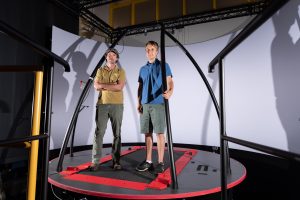By using mechanical energetics to measure stability, Georgia Tech researchers gained insights into how and why people fall. The aim was to develop an understanding of how devices and the human body work together, specifically at the intersection of three elements: muscle mechanics, wearable exoskeletons, and stability during walking. The new framework could open doors to advanced exoskeletons and prostheses that target specific joints to restore stabilizing responses in individuals with impaired balance.

While there has been extensive research into the biomechanics of falls, most current approaches study how the legs, joints, and muscles act separately to respond, rather than as a system. Pawel Golyski and Gregory Sawicki, PhD, Golyski’s doctoral advisor and associate professor of mechanical engineering and biological sciences at Georgia Tech, investigated whether mechanical energy can be used as a “common currency” to measure how humans use their lower limbs to stabilize themselves during walking. The research lays the groundwork for using mechanical energetics to understand the roles of joints and muscles during unsteady locomotion.
Golyski previously worked as a research scientist with individuals with lower-limb amputation at Walter Reed National Military Medical Center and will resume his work there upon completion of his doctoral degree. For his graduate work at Georgia Tech, he set out to develop an understanding of how devices
and the human body work together. Each component, muscle mechanics, wearable exoskeletons, and stability during walking, relates to the others. Exoskeletons affect a person’s stability while also affecting how their muscles work, and vice versa. But how changes in muscle dynamics relate to stability has not been well understood.
“The idea is that if we can relate stability to a demand in energy, then we can become accountants, and track how the energy—our currency—changes at the level of the person, muscle, and exoskeleton,” Golyski said. “That provides a really powerful framework to relate all three of those areas.”
Golyski and Sawicki designed an experiment with a person walking on a treadmill. Using a split-belt treadmill, they applied short, quick disturbances, known as perturbations, in the form of increases in belt
speed to one leg during walking. The purpose was to inject or extract energy during a stride, so that they could then measure how the person’s leg and joint energies change.
For the experiment they used the Computer Assisted Rehabilitation Environment (CAREN)— an integrated system used to study stability during movement. It features cameras mounted above a treadmill to track a person’s movement using motion capture markers attached to the person.
The system allowed the researchers to initiate perturbations at specific times in the gait cycle. By combining the force of the treadmill with the positional data collected by the CAREN, Golyski and Sawicki could calculate the changes in energy in a person’s individual joints. Their framework could assist in determining which part of a person’s body manages responses to destabilizing energy, pointing to specific muscles or joints to target with rehabilitation therapy.
Editor’s note: This story was adapted from materials provided by Georgia Tech.
The study, “Which lower limb joints compensate for destabilizing energy during walking in humans?,” was published in the Journal of the Royal Society Interface.




